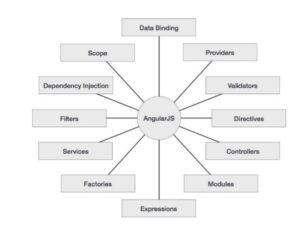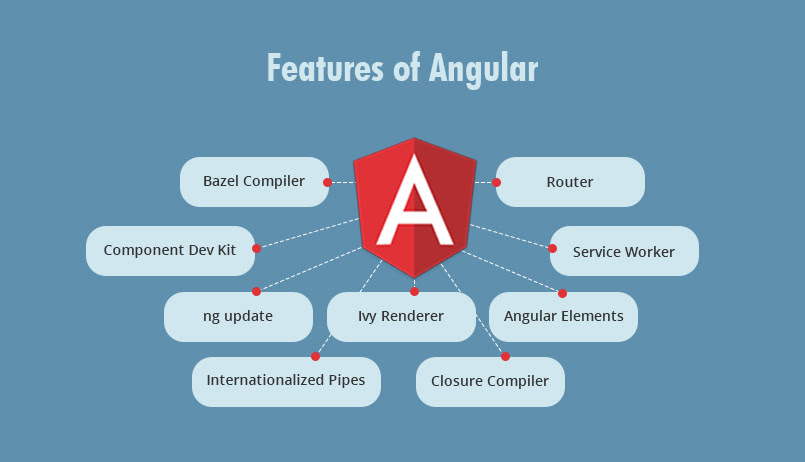AngularJS boasts a range of features that make it a powerful framework for building Rich Internet Applications (RIAs). With AngularJS, developers have the flexibility to write client-side applications using JavaScript in a clean Model-View-Controller (MVC) architecture. Moreover, applications developed with AngularJS are cross-browser compliant, as the framework automatically handles JavaScript code suitable for each browser. Being open-source and freely available, AngularJS is widely adopted by developers worldwide.
Overall, AngularJS is a comprehensive framework designed to facilitate the development of large-scale, high-performance, and easily maintainable web applications.
Core Features
- Data-binding: This feature enables automatic synchronization of data between model and view components.
- Scope: These objects serve as a link between the model and the controller, facilitating seamless communication.
- Controller: JavaScript functions bound to a specific scope.
- Services: AngularJS offers built-in services like $http for making XMLHttpRequests, ensuring efficient data handling.
- Filters: These aid in selecting a subset of items from an array and returning a new array.
- Directives: Markers on DOM elements, such as elements, attributes, and CSS, that enable the creation of custom HTML tags. AngularJS provides built-in directives like ngBind and ngModel.
- Templates: Rendered views containing information from the controller and model, which can be a single file or multiple views using partials.
- Routing: This concept involves switching views within an application.
- Model-View-Whatever (MVW): AngularJS implements a design pattern dividing an application into Model, View, and Controller, with distinct responsibilities. Though it does not strictly adhere to MVC, it follows a pattern closer to MVVM (Model-View-ViewModel).
- Deep Linking: Encodes the application’s state in the URL, allowing users to bookmark and restore the application from the URL.
- Dependency Injection: AngularJS features a built-in dependency injection subsystem, facilitating application creation, understanding, and testing.
Concepts
The diagram below illustrates key components of AngularJS, which will be explored in detail in subsequent chapters.

Advantages of AngularJS
AngularJS boasts several advantages that contribute to its popularity among developers:
- Streamlined Single Page Application Development: AngularJS simplifies the creation of Single Page Applications (SPAs) by providing a clean and maintainable structure.
- Enhanced User Experience: With built-in data binding capabilities, AngularJS delivers a rich and responsive user experience, ensuring seamless interaction.
- Unit Testability: AngularJS facilitates unit testing of code, enabling developers to ensure the reliability and robustness of their applications.
- Utilization of Dependency Injection: By leveraging dependency injection, AngularJS promotes separation of concerns and facilitates modular development.
- Reusability of Components: AngularJS encourages the creation of reusable components, allowing developers to efficiently build and maintain applications.
- Concise Code: Developers can achieve extensive functionality with minimal code, thanks to AngularJS’s concise syntax and powerful features.
- Browser Compatibility: AngularJS applications are compatible with all major browsers and mobile platforms, including Android and iOS devices.
Disadvantages of AngularJS
Despite its numerous advantages, AngularJS also presents some drawbacks:
- Security Concerns: AngularJS applications may face security vulnerabilities due to their JavaScript-only nature, necessitating robust server-side authentication and authorization mechanisms.
- Lack of Degradability: If JavaScript is disabled, AngularJS applications may not render properly, resulting in a degraded user experience.
AngularJS Directives
AngularJS revolves around three key directives:
- ng-app: This directive establishes and links an AngularJS application to HTML, defining its scope and functionality.
- ng-model: By binding AngularJS application data to HTML input controls, this directive facilitates dynamic data manipulation and interaction.
- ng-bind: This directive seamlessly integrates AngularJS application data with HTML tags, ensuring real-time data synchronization and rendering.
These directives serve as the building blocks of AngularJS applications, empowering developers to create dynamic and responsive web experiences.





Leave a Reply